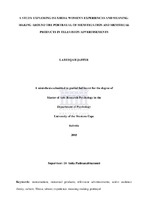| dc.description.abstract | Menstruation can be defined as the cyclic shedding of the uterine wall in response to the production of hormones from the ovaries. Although menstruation is experienced as both a positive and negative phenomenon, the dominant view remains a negative one. Menstruation has been stigmatised across most cultures, and culturally constructed as something that needs to be hidden, and hygienically managed, and a source of shame and embarrassment. It is also seen as a dirty process and a source of discomfort, illness and emotional instability. Dominant cultural constructions of menstruation in advertisements convey the message that through the purchase of particular menstrual products, women will be “protected”, “fresh”, and thus the cultural beliefs of a hygiene crisis, concealment and secrecy are perpetuated. This study explored isi-Xhosa speaking women’s experiences and meaning-making related to the portrayal of menstruation and menstrual products in television advertisements. Active audience theory, a branch of media theory, formed the theoretical framework for this study. This research adopted a qualitative approach, and made use of Interpretive Phenomenological Analysis (IPA) to explore participants’ personal experiences. Three focus groups were conducted in English, consisting of 5 participants per focus group. Research began with two focus groups until saturation was reached. Participants were shown two television advertisements of two major South African companies (Kotex and Always) who sell menstrual products, as a means of stimulating discussion. The findings indicated that there were major discrepancies between what was portrayed in menstrual product advertisements and the reality of participants’ experiences; there was an exaggerated emphasis on checking behaviours; menstrual product advertisements avoided displaying the discomfort associated with menstruation; advertisements heightened the fear around leaking and emphasised hygiene and remaining clean. The positive finding to emerge was participants’ view that menstrual product advertisements served as a means of education, in the context where they were often misinformed about menstruation or provided with minimal or no information. This study extended on a previous study conducted at a different South African university, and contributed to the literature in this area within the South African context. All ethical guidelines stipulated by the University of the Western Cape were strictly adhered to. | en_US |

